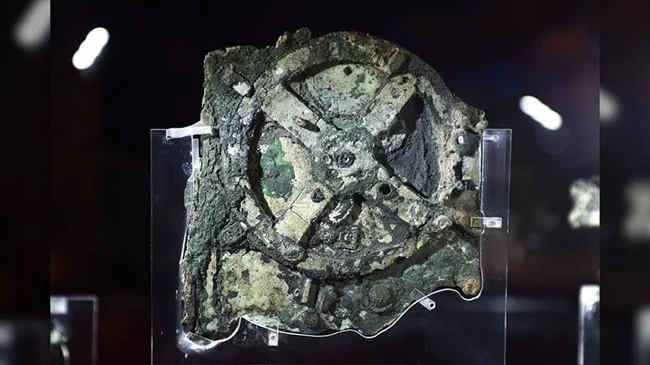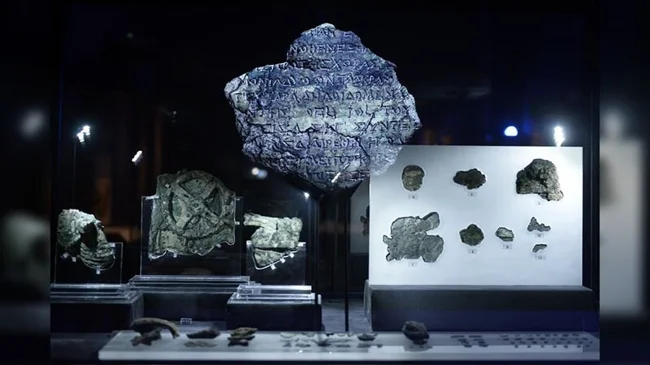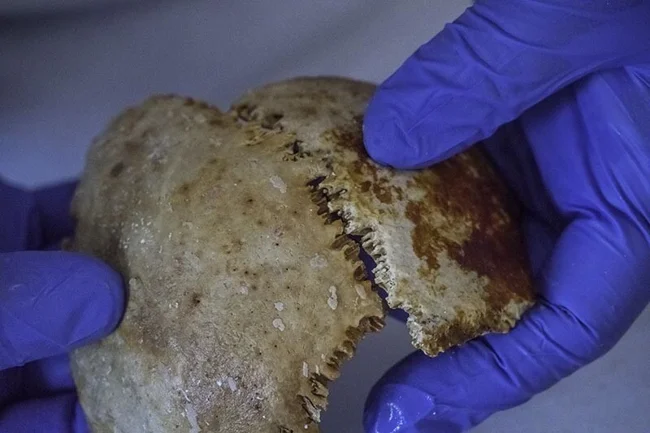Antikythera mechanism: ancient celestial calculator (5 photos)
The Antikythera Mechanism is an ancient shoebox-sized device that is sometimes called the world's oldest computer for its ability to perform astronomical calculations. 
The photograph taken at the Archaeological Museum in Athens on September 14, 2014 shows a fragment of the Antikythera Mechanism from the 2nd century BC. - a device known as the world's oldest computer that tracked astronomical phenomena and the cycles of the solar system.
Discovered by sponge divers off the Greek island of Antikythera in 1901, the remains of the mechanism are now housed in the National Archaeological Museum in Athens. To date, only 82 surviving fragments are known, representing about one-third of the original mechanism, the scientists wrote in a 2021 study published in the journal Scientific Reports. It was built about 2200 years ago.
What did the Antikythera Mechanism do?
The researchers write that the mechanism was capable of performing various calculations and could help track the movements of the Sun, Moon and five planets; he could even determine when sporting events such as the Olympic Games were to take place.
“It was a mechanical computer with bronze gears that used advanced technology to make astronomical forecasts, mechanizing astronomical cycles and theories,” the team wrote in the journal article.
Since the discovery of the Antikythera Mechanism, scientists have been trying to understand what it is and how it works. And although they have made significant progress, many questions still remain unanswered. For example, researchers are still not sure who created it. Some scientists claim that the creator of the mechanism was the Greek inventor Archimedes (287–212 BC), but there are doubts about this. The inscriptions on the mechanism are in Greek.
Whoever created the device must have known a lot about astronomy, metallurgy and mechanics, Aristeidis Voulgaris, leader of the team working on the functional reconstruction of the Antikythera Mechanism, told Live Science via email. This project aims to reconstruct what the mechanism originally looked like and gain a better understanding of it. It also required dexterous hands to handle it, he noted. 
An engraving depicting the last moments of the life of Archimedes, a mathematician who died in 212 or 211 BC when the Romans captured Syracuse, Sicily.
The discovered fragments of the mechanism contain writings and inscriptions, and over the past two decades, scientists have been able to read quite a lot of these Greek inscriptions using high-tech imaging techniques such as 3D X-ray scanning. This allowed them to learn more about how this mechanism functions.
The mechanism represents "a level of technology that surpasses anything else for which we have either physical remains or detailed descriptions from antiquity," said Alexander Jones, professor of ancient history at New York University's Institute for the Study of the Ancient World. .
What did the Antikythera Mechanism look like? 
Other parts of the Antikythera Mechanism in the Archaeological Museum in Athens.
The authors of the Scientific Reports article found that anyone looking at the front of the mechanism could see dials showing the movement of the Moon, the Sun, and the lunar nodes (the points where the Moon's orbit intersects the ecliptic, the great circle of the celestial sphere along which visible light occurs). On Earth, the annual movement of the Sun relative to the stars), Mercury, Venus, Mars, Jupiter and Saturn, as well as the zodiac calendar.
On the back of the mechanism were dials showing the metonic cycle (a 19-year cycle, after which the phases of the moon fall on the same days of the year), the callipic cycle (a period of 76 years, equal to four metonic cycles), the Olympic cycle (held every 4 years of the Olympic Games), the saros cycle (a period of more than 18 years between lunar eclipses) and exeligmos (a period of more than 54 years, or three saros cycles).
Between the front and back of the mechanism were a huge number of gears, designed in such a way that all dials displayed the correct time for all cycles.
“Suppose a user of the Antikythera Mechanism wanted to check the eclipse forecast for a certain month several years in advance. To do this, he would aim the mechanism at the desired date indicated in one of his calendars,” wrote Tony Freeth, a researcher with the Antikythera Mechanism Research Project, in a paper published in 2014 in the journal PLOS One.
Shipwreck 
This massive marble head, found in recent excavations at the site of the Antikythera Mechanism, is believed to represent a piece of the Greek demigod Hercules.
And although the ship containing the Antikythera Mechanism was discovered more than a century ago, its wreckage has not yet been fully excavated. The size of the ship he was on is also unknown, and it is also difficult to answer over what area the artifacts were scattered. Its location and depth make it difficult to excavate, according to the Woods Hole Oceanographic Institution (WHOI). The site sits at an angle on the seabed 130 to 165 feet (40 to 50 m) below the surface, meaning it is too deep for scuba divers, making it difficult to excavate for long periods of time, but too shallow to explore via remote controlled vehicles, according to WHOI.
Despite these difficulties, a team of archaeologists is carrying out a new excavation program and continues to find new artifacts that shed light on what the ship was like, which probably sank around 65 BC. Their finds include a bronze hand that was once attached to the statue, a board game, possible remains of an ancient throne and a marble head of a statue of Hercules, Live Science previously reported.
Researchers note that many of the artifacts were luxury items intended for the wealthy. To date, recent excavations have not uncovered any new remains of the mechanism. 
During excavations in 2016, a nearly intact skull was also discovered at the site where the Antikythera Mechanism was found.
In 2016, archaeologists discovered an ancient skeleton of a man at the site of a shipwreck, Live Science reports. Recently, scientists have made attempts to extract his DNA to find out more about this man.
Researchers are still not sure why this mechanism ended up on the ship in the first place.
“This was not an object that could be accidentally compromised during travel,” Jones wrote in his book.
And although this mechanism may not have been the only device of its kind, it was undoubtedly something of great value. In one version, the technician was transporting the device to its supposed owner, Jones wrote, noting that a storm may have caused the ship to sink, taking with it all its contents, including the mechanism. Where the ship came from and where it was heading is a subject of constant research and debate among scientists.
"Launch date" of the Antikythera Mechanism
Scientists are still debating the exact "start date" of the Antikythera Mechanism, the earliest date on which all calculations that can be made with the gadget are based. A study published in March 2022 on the preprint server arXiv proposed December 22, 178 BC as the launch date for the mechanism. The researchers noted that a lunar eclipse occurred on this day, followed by the winter solstice, followed by A holiday dedicated to the goddess Isis followed. Although Isis was an Egyptian goddess, she was also highly revered in Greece at the time.
However, other groups of scientists have proposed May 12, 204 BC as the most likely start date, noting that a lunar eclipse could be observed on that day in Greece and that this date is closer to the life of Archimedes. It is possible that he or someone who worked in his workshop could have built this device.
